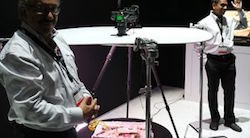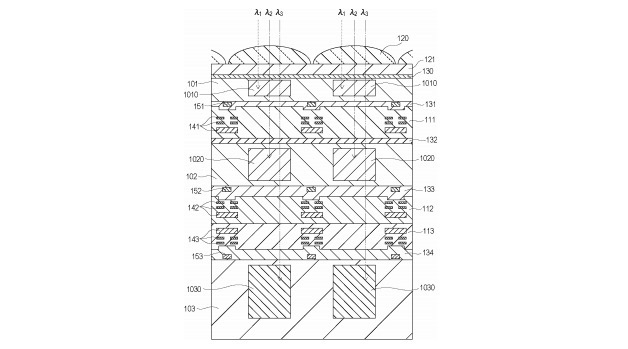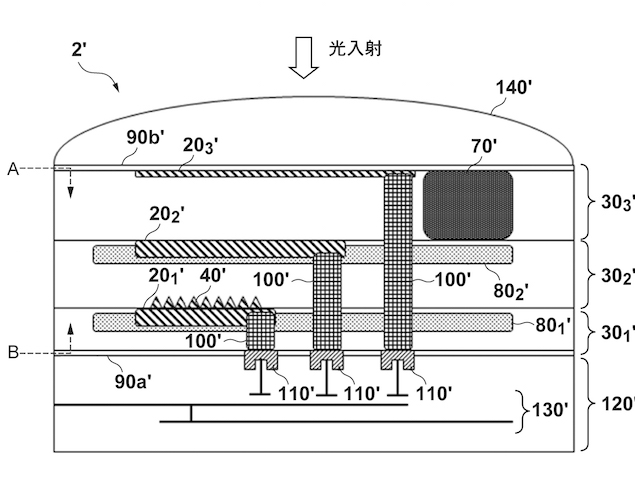Is Canon getting ready to abandon Bayer sensor striping? (Did their 120MP demo camera use Foveon-like technology?)
posted Thursday, October 29, 2015 at 4:21 PM EDT

On September 8th, Canon announced it is developing a 120-megapixel sensor destined for future DSLRs, displaying a working sample at their recent Canon Expo 2015 in New York City. While this may seem like a resurgence of the megapixel wars, we may be looking at something other than conventional RGBG or Bayer-striped sensor technology here. (The image above right shows a demonstration of the 120-megapixel camera prototype that Canon had set up at their recent Canon Expo 2015 in New York City.)
Recent rumors suggest that Canon might not be using the traditional Bayer approach for the color filtration on this megapixel monster, possibly finding a way around the limitations of the conventional color-striping approach used in pretty much every camera on the market, apart from those made by Sigma/Foveon.
We have a longstanding policy of not reporting on rumors, but recent Canon patents provide strong evidence that they've been working on multi-layer sensor technologies, that sample red, green, and blue light simultaneously in each pixel. This is similar in concept to what Foveon has been doing in their sensors for some years now, but the approaches Canon is taking introduce some refinements on the approach.

This multi-layer work has apparently been underway for some time, as the first patent we're aware of alluding to multi-layer sensor technology is this one, filed in November 2012 and published June of last year. That patent isn't specifically for a multi-layer sensor, but rather covers a way to use data from a sensor with individual layers for red, green, blue, UV and IR to improve color, and specifically skin-tone reproduction.

The second patent goes into a bit more detail on the specifics of a three-layer sensor. Based on the discussion on Egami, this patent appears to involve the use of anti-reflection layers between the photosensitive layers of a Foveon-type sensor, to improve the selectivity of the color filtration, and overall sensor efficiency. It's not clear from what we're able to interpret from the patent, but we wonder if the layers shown could consist of separate layers of silicon stacked mechanically, using the wafer-thinning technology employed in backside-illuminated sensor tech. (That would seem to be a very expensive, low-yield process, but we wonder how else Canon could create a structure with internal anti-reflection layers, unless by employing silicon-on-insulator crystal-growth technology - also likely to be a low-yield process.)

Last up is another patent from Canon, filed in October 2011 and published in May 2013, that details the workings of a three-layer sensor, with enhancements to increase its light sensitivity. As best we can tell from the typically garbled Google machine-translation of the patent, it appears to involve adjusting the 3-D structure of the interfaces between the different light-sensitive layers, essentially creating resonant cavities for the different wavelengths of light. This could potentially significantly increase light sensitivity, and once again improve color selectivity; both longtime bugaboos of the Foveon-type approach.
Of course, patents aren't products, with many never seeing the light of day in functioning systems. It's certainly interesting, though, that Canon has been investing as much effort as these patents suggest, in the same underlying technology as Foveon has been using. The Foveon approach has been shown to deliver exceptional detail, with no demosaicing artifacts, but has suffered from low light sensitivity and relatively high noise levels. At least some of this is due to the crosstalk between the red, green, and blue signals, which seems to be a focus of several Canon patents.
As noted at the outset, it's not our policy to report on rumors, but we thought it interesting in this case to observe just how much intellectual and engineering effort Canon seems to be investing in stacked-pixel technology.

